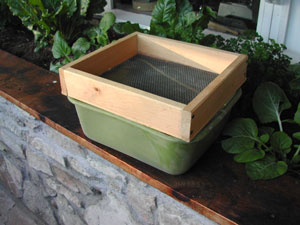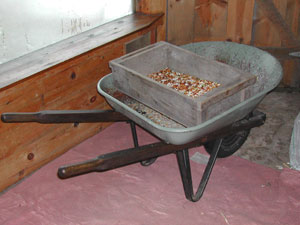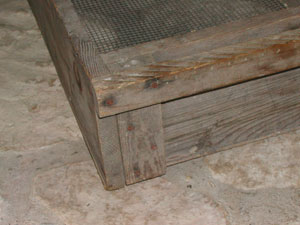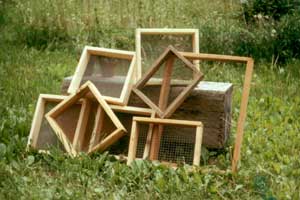SMALL SIFTERS
Our small sifters were made to fit on a common rectangular 12" x
14" Rubbermaid tub. This is handy as you can hold the sifter easily on the
tub, sifting whatever you are sifting into it without getting it all over,
whether it be dirt or cornmeal. They can be made whatever size fits your needs,
of course. The following sizes are for reference and a place to start. Adjust
accordingly.
Cut four 12 inch long 1 x 3’s. Commercial dimension 1 x 3 lumber is
actually 3/4 x 2 1/2. Any untreated and unpainted scrap lumber will do. Ours
happen to be of poplar and pine. Drill and countersink two holes in the ends of
two of the pieces if you want to be somewhat fancy, then screw the box together
with appropriate sized drywall screws. Nails work fine, too. Of course, if you
are really ambitious or just want to practice your woodworking skills on a
simple project, use dowels, or dovetails, or fingerjoints to join the corners.
No reason this can’t be more than a knock it together project. Just depends on
your druthers at that time, and how soon you want the sifter.
For now, we’ll go with screws. Screw the two end boards to the two side
boards making a box approximately 12" x 14". Make as many as you have
different screens to attach.
For my greenhouse soil sifting I use 1/4 inch hardware cloth for seed
starting medium, and 1/2 inch hardware cloth for flats and pots for transplants.
Sifting the compost/soil isn’t necessary, you can just pick out the biggest
uncomposted pieces and chunks as you fill your containers. The plants don’t
seem to care one way or the other. But is easier to lift plants out of sifted
soil. If you don’t sift, invariably you’ll carefully lift a little plant up
with its small ball of soil and along with it comes a long piece of root or
stalk or twig from nearby that dumps dirt and plants this way and that as it
comes along. So I sift.
I also have a number of other screens that I use mainly for seed cleaning in
the fall. It seems no matter what sizes you have, you’ll want another. Window
screen is easy to come by, for others you may have to do some creative
searching. Keep your eye open for anything suitable. We were lucky to obtain an
old, past-repairable, wooden hand cranked seed cleaning unit at an auction many
years ago. After it had taken up space for way too many years, we admitted it
would be more trouble than it was worth to rebuild and we cut up the many sized
screens that came with the unit and made them into small, portable sifters. One
unit stays in the kitchen to sift our home-grown, hand-milled, cornmeal.
Cut your screen just a bit small than the outside dimensions of your box so
the edges don’t stick out to snag and grab you. Staple the screen to the box.
Cut four 12" long small, thin strips of wood (such as 1/4" x
3/4"). Nail the strips with small nails over the screen along the box
edges. Your sifter is done. Isn’t it nice to have a short homestead project
for a change?
 LARGE SIFTER
LARGE SIFTER
Many years ago we stopped at a town garage sale on the way home from work.
Among the usual brik a’brak, there were a couple of pretty good finds. Steve
latched onto a small wooden nail keg full of odds and ends of pipe and whatnot
and I spied two large sifters. I wasn’t sure what I’d use them for, but they
were obviously well made, though well used, tools.
Few town garage sales yield such treasures for us.
The small wood keg is still in use today, and much of its treasure-trove of
odds and ends have found their way into one project or another. Most of the time
the keg sits at the end of our couch as a small end-table, with a top that is a
simple checkerboard we made in one of our early years of woodworking, when we
were having fun making hand-made wooden toys. The table-keg doubles as storage
for tie-down ropes and stakes and goes with us when we set up our portable shop
to demonstrate traditional woodworking.
The large sifters turned out to be tools that I am newly thankful for every
time I use them, which is off and on every year. They were made to be used and
to last. After probably 20 years of our use, in addition to the original owner’s
many years of use, they continue to fulfill that promise. There is no reason not
to think they will continue to do so well after this homesteader is gone. There
is a soul to a well made, used and cared for tool that most new tools just don’t
have.
These two sifters were made of scraps of wood and aren’t the same size, but
both of them fit a wheelbarrow just right to make them a pleasure to use. They
are deep enough for some serious work. Set crosswise, they fit down into the
wheelbarrow tub enough to be secure, but high enough to give room for whatever
you are sifting. One has 1/4" hardware cloth screen, and the other
1/2". I’ve used them to sift compost and peat moss for potting soil,
for cleaning threshed beans and peas for food and seed, and with gravel to separate sand from
stone, sometimes for the sand, sometimes for the stone. They work.
As with the smaller sifters, you can use what wood you have on hand,
adjusting sizes to suit your needs, your wood, and whatever container you might
be sifting into. Following is roughly how these are made. They work well with a
standard sized wheelbarrow tub.
 The box is made of 1 x 6 dimension lumber (roughly 3/4" x 5 1/2"
actual size). The sides are 25" long. The end boards are 12" long, set
in 3/4" from the ends. This allows a comfortable space for hand-holds.
Reinforcing spacers 1 3/4" wide and the same height as the box (5
1/2") are nailed in the outside corners of this space. Then a 1 1/2"
wide x 14 1/2" long piece is nailed across the entire width of the end, at
the upper edge of the box. These pieces, which are handles, can be rounded in
the center area for comfort. Long nails are used throughout and clinched on the
inside. There is no concern about this box falling apart.
The box is made of 1 x 6 dimension lumber (roughly 3/4" x 5 1/2"
actual size). The sides are 25" long. The end boards are 12" long, set
in 3/4" from the ends. This allows a comfortable space for hand-holds.
Reinforcing spacers 1 3/4" wide and the same height as the box (5
1/2") are nailed in the outside corners of this space. Then a 1 1/2"
wide x 14 1/2" long piece is nailed across the entire width of the end, at
the upper edge of the box. These pieces, which are handles, can be rounded in
the center area for comfort. Long nails are used throughout and clinched on the
inside. There is no concern about this box falling apart.
Hardware cloth is attached to the bottom of the box and 1/4" strips
nailed over the screening along the bottom edges. If you have scraps of hardware
cloth that aren’t big enough to go all the way, you can butt two pieces and
stitch them together with wire across the opening. One of our sifters is made
this way and it has worked just fine.
Another one of those humble homemade homestead tools that spend much of their
lives resting comfortably in the back of the shed is now a part of the
community. When the need arises, the tool comes to life, and time, tool, and
worker blend to perform yet another bit of magic in the everyday life of the
homestead.
* * * * * *
Copyright
© 2003 by Susan Robishaw





 LARGE SIFTER
LARGE SIFTER The box is made of 1 x 6 dimension lumber (roughly 3/4" x 5 1/2"
actual size). The sides are 25" long. The end boards are 12" long, set
in 3/4" from the ends. This allows a comfortable space for hand-holds.
Reinforcing spacers 1 3/4" wide and the same height as the box (5
1/2") are nailed in the outside corners of this space. Then a 1 1/2"
wide x 14 1/2" long piece is nailed across the entire width of the end, at
the upper edge of the box. These pieces, which are handles, can be rounded in
the center area for comfort. Long nails are used throughout and clinched on the
inside. There is no concern about this box falling apart.
The box is made of 1 x 6 dimension lumber (roughly 3/4" x 5 1/2"
actual size). The sides are 25" long. The end boards are 12" long, set
in 3/4" from the ends. This allows a comfortable space for hand-holds.
Reinforcing spacers 1 3/4" wide and the same height as the box (5
1/2") are nailed in the outside corners of this space. Then a 1 1/2"
wide x 14 1/2" long piece is nailed across the entire width of the end, at
the upper edge of the box. These pieces, which are handles, can be rounded in
the center area for comfort. Long nails are used throughout and clinched on the
inside. There is no concern about this box falling apart.